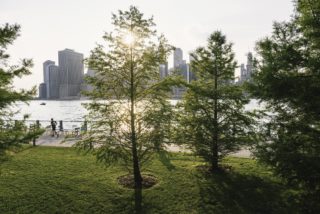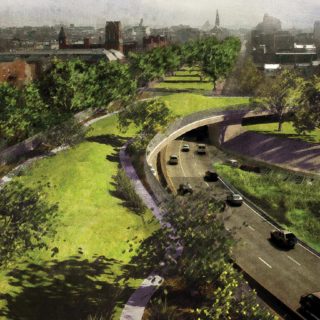



Tatiana V. Choulika, ASLA
Principal, James Corner Field Operations
Design with Nature (American Museum of Natural History Press, 1969)
By Ian L. McHarg
“So many people in our office have ties to the University of Pennsylvania, where the entire land-scape architecture program was based on McHarg’s philosophy. The book was a departure from hyper-controlling 20th-century hard-lines and mowed lawns. We were trained to think we must change our attitudes and make nature a partner, to make nature a part of the solution, and let her tell what she knows, give her a bit of control.”
Kate Orff, RLA, FASLA
Founding principal, SCAPE; professor and director of the Urban Design Program at Columbia University
All We Can Save: Truth, Courage, and Solutions for the Climate Crisis (One World Trade, 2021)
Edited by Ayana Elizabeth Johnson and Katharine K. Wilkinson
“An array of all-female contributors tells stories of love, creativity, grit, and activism to reorientation relative to the climate emergency.”
The Nature of Oaks: The Rich Ecology of Our Most Essential Native Trees (Timber Press, 2021)
By Douglas W. Tallamy
“Tallamy paints a portrait of the vast insect, bird, and mammal life engendered by oaks.”
The Overstory (Norton, 2018)
By Richard Powers
“The Overstory, which won a Pulitzer Prize for Fiction in 2019, envisions a culture and connectivity of all living things.”

Mitchell Joachim, Ph.D. Assoc. AIA
Co-founder, Terreform ONE; associate professor of practice at New York University
Ministry for the Future (Hachette, 2020)
By Kim Stanley Robinson
“It’s a fictive narrative, and it’s insanely good. It takes place in India, where there’s a massive heat wave and 30 million people basically melt to death. You would think that would send off this signal about why climate change is an issue and why it’s important, but instead it becomes a political issue based on the region you’re located in. So people don’t see it as a global problem; it just sort of shifts from something local to something regional. The United Nations uses a black ops group to implement what they want to do, because it just doesn’t work if you’re trying to do everything politically and appeal to all nations equally. It hasn’t worked for 30 years. I’m not finished with it, but it’s absolutely engrossing.”

The Ecology of Freedom (AK Press, 2005)
By Murray Bookchin
“For core readings that are necessary for resilience, this older text is very useful on socioecological design. Bookchin is basically the pre-version of Bernie Sanders politically. He is also anti-futurist, anti-Buckminster Fuller, which I am not. It’s all post-capitalist thinking, and he’s laying the groundwork for the Anthropocene before that became a thing. Noam Chomsky is a big supporter of Bookchin.”
Video: “Victor Papanek’s June 1992 Presentation at Apple Computer—‘Microbes in the Tower.’”
(YouTube: Design Learning Network, 2014)
“I’d recommend almost any book by Victor Papanek, or watch his lecture at Apple computers. He basically takes down the minimalism associated with Apple and tries to say, this might be the wrong direction, if we want to think about sustainable long-term goals and material usage for industrially designed objects. He says there are upcycling systems already in place that might not have that clean look, but that will be very valuable in the long term. He’s very much about the idea of ad hoc and cobbling together different elements to get to these very hardcore, fundamental designs. When we look at his design philosophy, they look like mockups. He’s basically the king of mockups. I’m of both schools, but from an academic point of view, it’s good to look at doing things that are regenerative and resilient.”

Cradle to Cradle (North Point, 2002) and The Upcycle
(North Point, 2013)
By William McDonough and Michael Braungart
“I don’t know how much Bill McDonough one could absorb, but I’d say read both these books. He talks about how waste equals food, and that design needs to be made up of intelligent nutrients. He believes that complex industrially designed objects that have higher functions should constantly be upcycled and never thrown out, like a cell phone: just replace the chip or part of the interface, but don’t throw out the whole cell phone. I don’t know anyone who’s really locked in that argument better than McDonough.”
Video: “Fred A. Bernstein: Negative Energy and (Dis)Embodied Carbon”
(Vimeo: Princeton School of Architecture, 2021)
“Bernstein also critiques Apple, in this case their Norman Foster-designed headquarters. He says we just can’t claim buildings are green, even if the intentions are brilliant and the architects are doing everything they can to make a building green. It’s still not there; we don’t have quite the right measurement system.”

Ecology of Building Materials (Routledge, 2009)
By Bjørn Berge
“This is the go-to for straight-up facts and figures on building materials.”

The Story of Stuff: The Impact of Overconsumption on the Planet, Our Communities, and Our Health—And How We Can Make It Better (Free Press, 2010)
By Annie Leonard
“This is an absolutely brilliant book. Everyone should read it and realize we are not ‘consumers’—we are citizens of this world. We’re not here to buy stuff all the time. And that mentality is disgusting. Annie Leonard says this in a calm, politically neutral way, and hits just the right tone, which could help architects understand how to interface with their clients on these questions, and not go overboard in the materials we put into buildings.”
—
Tom Stoelker is a senior staff writer at Fordham University. As a freelancer, he writes about and photographs the urban landscape for The Philadelphia Inquirer, The Wall Street Journal, The Architect’s Newspaper, and Landscape Architecture Magazine.












